Quantifying Variability in Maize Yield Response to Nutrient Applications in the Northern Nigerian Savanna
Abstract
:1. Introduction
2. Materials and Methods
2.1. Site Selection and Description
2.2. Experimental Design, Management and Laboratory Analyses
2.3. Data Analysis
3. Results
3.1. Soil Physicochemical Characteristics
3.2. Yield Response to Fertilizer Treatments
3.3. Yield-Nutrients Variability Response Clusters
- Cluster I: Fields without yield response to any nutrient application, therefore called “no response fields.” Attainable yield level in this cluster fell between 3 and 3.7 t·ha−1 for OPV and 2.7 and 3.8 t·ha−1 for the hybrid variety, respectively. The cluster contains 9% and 16% of the OPV and hybrid study fields, respectively (Table 7). Among the four clusters, the fields in this cluster received the largest manure application preceding the trials and the smallest urea fertilizer application (Table 8). As a result, the fields in this cluster have the highest soil organic C content. In addition, fields in this cluster also have the highest available Fe content.
- Cluster II: Fields with a large yield response to N and P, hence known as “N and P response fields.” Attainable yield levels were 4.6 to 4.8 t·ha−1 and 4.8 to 5.3 t·ha−1 for OPV and hybrid variety, respectively (Figure 7). It is the largest cluster containing 63% of the study fields in both OPV and hybrid trials (Table 7). Using no-response cluster I as the reference category, multinomial logistic regression as indicated by significant odds ratios (Table 8), showed that relatively low soil organic C, small Fe and high available S were the soil properties statistically responsible for allocation of fields into this cluster.
- Cluster III: Fields with a larger yield response to N only and a small response to P, K and SMM (secondary macro- and micro-nutrients), therefore called “N response fields.” The attainable yield in this cluster fell between 4.7 and 5.8 t·ha−1 for OPV and 5.1 and 5.3·ha−1 for hybrid, respectively (Figure 7). Twenty eight percent (28%) and 17% of OPV and hybrid study fields, respectively are assigned to this cluster (Table 7). Low soil organic C, high available P and high bulk density relative to the corresponding values in the reference cluster I (Table 8) were the significant soil characteristics responsible for the allocation of fields into this cluster.
- Cluster IV: Fields in this cluster have a large yield response to N and SMM, a small response to P and K. Therefore, they are called “N and SMM response fields.” Addition of SMM increased yield by 1.4 t·ha−1 over the NPK. Cluster IV held only 4.0% of the hybrid fields (Table 7) and holds the largest attainable yield compared to all other clusters of 6.4 to 8.3 t·ha−1 (Figure 7). High soil available P as twice the average content of the reference cluster I and low organic C and available B contents were the significant soil characteristics of fields for this cluster (Table 8). In addition, fields in this cluster received the smallest organic matter input and the largest NPK applications before the trials.
4. Discussion
4.1. Soil Characteristics
4.2. Variability in Yield Response to Nutrient Application
4.3. Management
5. Conclusions
Acknowledgments
Author Contributions
Conflicts of Interest
References
- Adesoji, A.G.; Abubakar, I.U.; Labe, D.A. Economic performance of maize under incorporated legumes and nitrogen in northern Guinea savanna zone of Nigeria. Asian J. Agric. Res. 2016, 10, 38–46. [Google Scholar] [CrossRef]
- Food and Agriculture Organization of the United Nations (FAOSTAT). Available online: faostat3.fao.org/download/Q/QC/E (accessed on 3 March 2016).
- Fakorede, M.A.B.; Akinyemiyu, O.A. Climatic change: Effects on maize production in a tropical rainforest location. In Maize Revolution in West and Central Africa, Proceedings of Regional Maize Workshop, Cotonou, Benin, 14–18 May 2001; Badu-Apraku, B., Fakorede, M.A.B., Ouedraogo, M., Carsky, R.J., Menkir, A., Eds.; West and Central Africa Collaborative Maize Research Network (WECAMAN), International Institute of Tropical Agriculture (IITA): Idaban, Nigeria, 2003; pp. 272–282. [Google Scholar]
- Global Yield Gap Atlas. Basic Data Nigeria. Available online: http://www.yieldgap.org/ (accessed on 24 July 2017).
- Sileshi, G.; Akinnifesi, F.K.; Debusho, L.K.; Beedy, T.; Ajayi, O.C.; Mong’omba, S. Variation in maize yield gaps with plant nutrient inputs, soil type and climate across sub-Saharan Africa. Field Crop. Res. 2010, 116, 1–13. [Google Scholar] [CrossRef]
- Omobolanle, L.; Ewuola, S.O.L.U.; Daramola, A.G. Socio-economic impact assessment of maize production technology on farmers’ welfare in southwest, Nigeria. J. Cent. Eur. Agric. 2005, 6, 15–26. [Google Scholar]
- Girei, A.A.; Galadima, O.E. Resource-use efficiency and profitability of maize production in Lafia local government area of Nasarawa state, Nigeria. Eur. J. Acad. Essays 2016, 3, 234–238. [Google Scholar]
- Bojo, J. The costs of land degradation in Sub-Saharan Africa. Ecol. Econ. 1996, 16, 161–173. [Google Scholar] [CrossRef]
- Ekeleme, F.; Jibrin, J.M.; Kamara, A.Y.; Oluoch, M.; Samndi, A.M.; Fagge, A.A. Assessment of the relationship between soil properties, Striga hermonthica infestation and the on-farm yields of maize in the dry Savannas of Nigeria. Crop Prot. 2014, 66, 90–97. [Google Scholar] [CrossRef]
- Jones, M.J.; Wild, A. Soils of West African Savanna; Technical Communication No. 55; Common Wealth Bureau of Soils: Harpenden, UK, 1975.
- Federal Department of Agricultural Land Resources (FDALR). Assessment of Soil Degradation in Nigeria; Project Report; Federal Department of Agricultural Land Resources: Abuja, Nigeria, 1999.
- Federal Fertilizer Department (FFD). Fertilizer Use and Management Practices for Nigeria, 4th ed.; Federal Fertilizer Department, Federal Ministry of Agriculture and Rural Development: Abuja, Nigeria, 2012.
- Manu, A.; Bationo, A.; Geiger, S.C. Fertility status of selected millet producing soils of West Africa with emphasis on phosphorus. Soil Sci. 1991, 152, 315–320. [Google Scholar] [CrossRef]
- Shehu, B.M.; Jibrin, J.M.; Samndi, A.M. Fertility status of selected soils in the Sudan savanna biome of northern Nigeria. Int. J. Soil Sci. 2015, 10, 74–83. [Google Scholar] [CrossRef]
- Hengl, T.; Leenaars, J.G.B.; Shepherd, K.D.; Walsh, M.G.; Heuvelink, G.B.M.; Mamo, T.; Tilahun, H.; Berkhout, E.; Cooper, M.; Fegraus, E.; et al. Soil nutrient maps of Sub-Saharan Africa: Assessment of soil nutrient content at 250 m spatial resolution using machine learning. Nutr. Cycl. Agroecosyst. 2017, 109, 77–102. [Google Scholar] [CrossRef]
- Lombin, G. Soil and climatic constraints to crop production in the Nigerian savanna region. In Proceedings of the 15th Annual Conference of Soil Science Society of Nigeria, Kaduna, Nigeria, 20–24 September 1987; Soil Science Society of Nigeria: Kaduna, Nigeria, 1987. [Google Scholar]
- Nziguheba, G.; Tossah, B.K.; Diels, J.; Franke, A.C.; Aihou, K.; Iwuafor, E.N.O.; Nwoke, C.; Merckx, R. Assessment of nutrient deficiencies in maize in nutrient omission trials and long-term field experiments in the West African Savanna. Plant Soil 2009, 314, 143–157. [Google Scholar] [CrossRef]
- Hassan, A.M.; Ogbonnaya, C.S. Status and distribution of available micronutrient in Udic Kanhaplustults of Bauchi local government area, Bauchi state. Sch. J. Agric. Vet. Sci. 2016, 3, 257–261. [Google Scholar]
- Food and Agriculture Organization of the United Nations (FAOSTAT). Available online: http://www.fao.org/faostat/en/#country/159 (accessed on 14 December 2017).
- Morris, M.; Kelly, V.A.; Kopicki, R.J.; Byerlee, D. Fertilizer Use in African Agriculture Lessons Learned and Good Practice Guidelines; The World Bank: Washington, DC, USA, 2007. [Google Scholar]
- Sheahan, M.; Barrett, C.B. Understanding the Agricultural Input Landscape in Sub-Saharan Africa: Recent Plot, Household and Community-Level Evidence; Policy Research Working Paper No. 7014; World Bank Group: Washington, DC, USA, 2014; pp. 1–87. [Google Scholar]
- Deckers, J. A systems approach to target balanced nutrient management in soilscapes of Sub-Saharan Africa. In Itegrated Plant Nutrient Management in Sub-Saharan Africa; Vanlauwe, B., Diels, J., Sanginga, N., Merckx, R., Eds.; CAB International: Wallingford, UK, 2002. [Google Scholar]
- Tittonell, P.; Vanlauwe, B.; Leffelaar, P.A.; Shepherd, K.D.; Giller, K.E. Exploring diversity in soil fertility management of smallholder farms in western Kenya: II. Within-farm variability in resource allocation, nutrient flows and soil fertility status. Agric. Ecosyst. Environ. 2005, 110, 166–184. [Google Scholar] [CrossRef]
- Vanlauwe, B.; Chianu, J.; Giller, K.E.; Merckx, R.; Mokwunye, U.; Pypers, P.; Shepherd, K.; Smaling, E.; Woomer, P.L.; Sanginga, N. Integrated soil fertility management: Operational definition and consequences for implementation and dissemination. Outlook Agric. 2010, 39, 17–24. [Google Scholar] [CrossRef]
- Friesen, D.K. Fate and efficiency of sulfur fertilizer applied to food crops in West Africa. Fertil. Res. 1991, 29, 35–44. [Google Scholar] [CrossRef]
- Ojeniyi, S.O.; Kayode, G.O. Response of maize to copper and sulfur in tropical regions. J. Agric. Sci. Camb. 1993, 120, 295–299. [Google Scholar] [CrossRef]
- Weil, R.R.; Mughogho, S.K. Sulfur nutrition of maize in four regions of Malawi. Agron. J. 2000, 92, 649–656. [Google Scholar] [CrossRef]
- Perez-Quezada, J.; FPettygrove, G.S.; Plant, R.E. Spatial—Temporal analysis of yield and soil factors in two-fourcCrop—Rotation fields in the Sacramento valley, California. Agron. J. 2003, 95, 676–687. [Google Scholar] [CrossRef]
- Fridgen, J.J.; Kitchen, N.R.; Sudduth, K.A.; Drummond, S.T.; Wiebold, W.J.; Fraisse, C.W. Management zone analyst (MZA): Software for subfield management zone. Agron. J. 2004, 96, 100–108. [Google Scholar]
- Kihara, J.; Nziguheba, G.; Zingore, S.; Coulibaly, A.; Esilaba, A.; Kabambe, V.; Njoroge, S.; Palm, C.; Huising, J. Understanding variability in crop response to fertilizer and amendments in sub-Saharan Africa. Agric. Ecosyst. Environ. 2016, 229, 1–12. [Google Scholar] [CrossRef] [PubMed]
- Njoroge, S.; Schut, A.G.T.; Giller, K.E.; Zingore, S. Strong spatial-temporal patterns in maize yield response to nutrient additions in African smallholder farms. Field Crop. Res. 2017, 214, 321–330. [Google Scholar] [CrossRef]
- Federal Department of Agricultural Land Resources (FDALR). The Reconnaissance Soil Survey of Nigeria (1:65,000); Soils Report Volume 2; Federal Department of Agricultural Land Resources: Abuja, Nigeria, 1990.
- Malgwi, W.B.; Tarfa, B.D.; Daudu, C.; Arunah, L.; Omadachi, U.; Idonga, S.; Musa, L.; Amapu, I.Y.; Kuchinda, N.C.; Atala, T.K.; et al. Final Report on Semi-Detail Soil Survey of Selected Areas along Cotton Value Chain in Katsina (Bakori), Zamfara (Tsafe) and Adamawa (Numan); Federal Ministry of Agriculture and Rural Development of Land Resources: Abuja, Nigeria, 2013.
- Muhammad, B. Characterization and Fertility Capability Classification of Some Soils on the Basement Complex in Kano State, Nigeria. Master’s Thesis, Bayero University Kano, Kano, Nigeria, 2016. [Google Scholar]
- Malgwi, W.B.; Tarfa, B.D.; Daudu, C.; Arunah, L.; Omadachi, U.; Idonga, S.; Musa, L.; Amapu, I.Y.; Kuchinda, N.C.; Atala, T.K.; et al. Final Report on Semi-Detail Soil Survey of Selected Areas along Otton Value Chain, Second Phase in Katsina (Funtua), Zamfara (Gusau), Ogun (Imeko Afon, Yewa North) and Oyo (Iseyin); Federal Ministry of Agriculture and Rural Develoment of Land Resources: Abuja, Nigeria, 2014.
- Magaji, M.J. Soil Characterization and Development of Pedotransfer Functions for Estimating Soil Properties in Nigerian Northern and Southern Guinea Savanna. Master’s Thesis, Bayero University Kano, Kano, Nigeria, 2015. [Google Scholar]
- Jones, A.; Breuning-Madison, H.; Brossard, M.; Dampha, A.; Deckers, J.; Dewitte, O.; Gallali, T.; Hallet, S.; Jones, R.; Kilsara, M.; et al. Soil Atlas of Africa; European Commission, Publications of the European Union: Luxembourg, 2013. [Google Scholar]
- Blake, G.R.; Hartge, K.H. Bulk density, methods of soil analysis. In Part 1. Physical and Mineral Method; Klute, A., Ed.; American Society of Agronomy (ASA), Soil Science Society of America (SSSA): Madison, WI, USA, 1986. [Google Scholar]
- Heanes, D.L. Determination of total organic-C in soils by an improved chromic acid digestion and spectrophotometric procedure. Commun. Soil Sci. Plant Anal. 1984, 15, 1191–1213. [Google Scholar] [CrossRef]
- Bremner, J.M. Nitrogen-Total. In Methods of Soil Analysis: Chemical Methods; Sparks, D.L., Ed.; American Society of Agronomy and Soil Science Society of America: Madison, WI, USA, 1996. [Google Scholar]
- Gee, G.W.; Or, D. Particle-size analysis. In Methods of Soil Analysis. Part 4. Physical Methods; Dane, J.H., Topp, G.C., Eds.; Soil Science Society of America Book Series 5; Soil Science Society of America: Madison, WI, USA, 2002. [Google Scholar]
- Mehlich, A. Mehlich 3 soil test extractant: A modification of Mehlich 2 extractant. Commun. Soil Sci. Plant Anal. 1984, 15, 1409–1416. [Google Scholar] [CrossRef]
- Anderson, J.M.; Ingram, J.S.I. Tropical Soil Biology and Fertility (TSBF). A Hand Book of Methods, 2nd ed.; CABI International: Wallingford, UK, 1993. [Google Scholar]
- SAS Institute Inc. JMP® 13 Documentation Library; SAS Institute Inc.: Cary, NC, USA, 2017. [Google Scholar]
- Wilding, L.P. Spatial variability: Its documentation, accommodation and implication to soil surveys. In Soil Spatial Variability; Nielsen, D.R., Bouma, J., Eds.; Pudoc: Wageningen, The Netherlands, 1985. [Google Scholar]
- Raun, W.R.; Barreto, H.J.; Westerman, R.L. Use of stability analysis for long-term soil fertility experiments. Agron. J. 1993, 85, 159–167. [Google Scholar] [CrossRef]
- Bronikowski, A.; Cobb, W. Appendix: A critical examination of rainfall variability measures used in behavioral ecology studies. Behav. Ecol. Sociobiol. 1996, 39, 27–30. [Google Scholar] [CrossRef]
- Sarle, W.S. The Cubic Clustering Creterion; SAS Technical Report A-108; SAS Institute Inc.: Cary, NC, USA, 1983. [Google Scholar]
- Arshad, M.A.; Lowery, B.; Grossman, B. Physical tests for monitoring soil quality. In Methods for Assessing Soil Quality; Doran, J.W., Jones, A.J., Eds.; Soil Science Society of America: Madison, WI, USA, 1996. [Google Scholar]
- National Special Programme for Food Security (NSPFS). Nigerian Soil Fertility Rating and Thematic Maps; National Special Programme for Food Security: Abuja, Nigeria, 2005. [Google Scholar]
- Horneck, D.A.; Sullivan, D.M.; Owen, J.S.; Hart, J.M. Soil Test Interpretation Guide; Oregon State University Extension Publication EC 1478; Oregon State University: Corvallis, OR, USA, 2011. [Google Scholar]
- Esu, I.E. Detailed Soil Survey of NIHORT Farm at Bunkure Kano State, Nigeria; Ahmadu Bello University Zaria: Kaduna, Nigeria, 1991. [Google Scholar]
- Brady, N.C.; Weil, R.R. The Nature and Properties of Soils, 13th ed.; Pearson Education: Singapore, 2002; ISBN 9780130167637. [Google Scholar]
- Voncir, N.; Mustapha, S.; Tenebe, V.A.; Kumo, A.L.; Kushwaha, S. Content and profile distribution of extractable zinc (Zn) and some physicochemical properties of soil along a toposequence at Bauchi, Northern Guinea Savanna of Nigeria. Int. J. Soil Sci. 2008, 3, 62–68. [Google Scholar] [CrossRef]
- Malgwi, W.B.; Ojanuga, A.G.; Chude, V.O.; Kparmwang, T.; Raji, B.A. Morphological and physical properties of some soils at Samaru, Zaria, Nigeria. Niger. J. Soil Resour. 2000, 1, 58–64. [Google Scholar]
- Kwari, J.D.; Kamara, A.Y.; Ekeleme, F.; Omoigui, L. Soil fertility variability in relation to the yields of maize and soybean under intensifying cropping systems in the tropical savannas of northeastern Nigeria. In Innovations as Key to the Green Revolution in Africa: Exploring the Scientific Facts; Bationo, A., Waswa, B., Okeyo, J.M., Maina, F., Kihara, J.M., Eds.; Springer: Dordrecht, The Netherlands, 2011; pp. 457–464. [Google Scholar]
- Kamara, A.Y.; Ekeleme, F.; Jibrin, J.M.; Tarawali, G.; Tofa, I. Assessment of level, extent and factors influencing Striga infestation of cereals and cowpea in a Sudan savanna ecology of northern Nigeria. Agric. Ecosyst. Environ. 2014, 188, 111–121. [Google Scholar] [CrossRef]
- Møberg, J.P.; Esu, I.E. Characteristics and composition of some savanna soils in Nigeria. Geoderma 1991, 48, 113–129. [Google Scholar] [CrossRef]
- Sillanpää, M. Micronutrients and the Nutrient Status of Soils: A Global Study; FAO Soil Bulletin 48; Werner Söderström Osakeyhtiö Publishers: Helsinki, Finland, 1982. [Google Scholar]
- Aref, F. Concentration and uptake of zinc and boron in corn leaf as affected by zinc sulfate and boric acid fertilizers in a deficient soil. Life Sci. J. 2011, 8, 26–32. [Google Scholar]
- Ahmad, W.; Zia, M.H.; Malhi, S.S.; Niaz, A.; Saifullah. Boron deficiency in soils and crops: A Review. In Crop Plant; Goyal, A., Ed.; InTech: Rijeka, Croatia, 2012; pp. 77–114. ISBN 978-953-51-0527-5. [Google Scholar]
- Kamara, A.Y.; Menkir, A.; Ajala, S.O.; Kureh, I. Performance of diverse maize genotypes under nitrogen deficiency in the northern Guinea savanna of Nigeria. Exp. Agric. 2005, 41, 199–212. [Google Scholar] [CrossRef]
- Kamara, A.Y.; Ewansiha, S.U.; Menkir, A. Assessment of nitrogen uptake and utilization in drought tolerant and Striga resistant tropical maize varieties. Arch. Agron. Soil Sci. 2014, 60, 195–207. [Google Scholar] [CrossRef]
- Adnan, A.A.; Jibrin, J.M.; Kamara, A.Y.; Abdulrahman, B.L.; Shaibu, A.S. Using CERES-Maize model to determine the nitrogen fertilization requirements of early maturing maize in the Sudan Savanna of Nigeria. J. Plant Nutr. 2017, 40, 1066–1082. [Google Scholar] [CrossRef]
- Vanlauwe, B.; Kihara, J.; Chivenge, P.; Pypers, P.; Coe, R.; Six, J. Agronomic use efficiency of N fertilizer in maize-based systems in sub-Saharan Africa within the context of integrated soil fertility management. Plant Soil 2011, 339, 35–50. [Google Scholar] [CrossRef]
- Badu-Apraku, B.; Fakorede, M.A.B.; Oyekunle, M.; Yallou, G.C.; Obeng-Antwi, K.; Haruna, A.; Usman, I.S.; Akinwale, R.O. Gains in grain yield of early maize cultivars developed during three breeding eras under multiple environments. Crop Sci. 2015, 55, 527–539. [Google Scholar] [CrossRef]
- Zingore, S.; Delve, R.J.; Nyamangara, J.; Giller, K.E. Multiple benefits of manure: The key to maintenance of soil fertility and restoration of depleted sandy soils on African smallholder farms. Nutr. Cycl. Agroecosyst. 2008, 80, 267–282. [Google Scholar] [CrossRef]
- Agboola, A.A.; Ayedele, O.J. Prospects and problems of using soil testing for adoption of fertilizer use in Ekiti-Akoko agricultural develepment project area. In Proceedings of Workshops on Appropriate Technologies for Farmers in Semi-Arid West Africa, 2–5 April 1985; Purdue University: West Lafayette, IN, USA, 1985; pp. 123–136. [Google Scholar]
- Federal Ministry of Agriculture and Natural Resources (FMANR). Literature Review in Soil Fertility Investigations in Nigeria (in Five Volumes); Federal Ministry of Agriculture and Natural Resources: Lagos, Nigeria, 1990.
- Giller, K.E.; Tittonell, P.; Rufino, M.C.; van Wijk, M.T.; Zingore, S.; Mapfumo, P.; Adjei-Nsiah, S.; Herrero, M.; Chikowo, R.; Corbeels, M.; et al. Communicating complexity: Integrated assessment of trade-offs concerning soil fertility management within African farming systems to support innovation and development. Agric. Syst. 2011, 104, 191–203. [Google Scholar] [CrossRef]
- Ros, G.H.; Hanegraaf, M.C.; Hoffland, E.; van Riemsdijk, W.H. Predicting soil N mineralization: Relevance of organic matter fractions and soil properties. Soil Biol. Biochem. 2011, 43, 1714–1722. [Google Scholar] [CrossRef]
- Redi, M.; Gebremedhin, W.; Merkeb, F. Critical level of extractable phosphorus for maize (Zea mays L.) at Metekel zone, northwestern Ethiopia. World Sci. News 2016, 54, 14–26. [Google Scholar]
- Janssen, B.H.; Lathwell, D.J.; Wolf, J. Modeling long-term crop response to fertilizer phosphorus. II. Comparison with field results. Agron. J. 1987, 79, 452–458. [Google Scholar] [CrossRef]
- Witt, C.; Dobermann, A.; Abdulrachman, S.; Gines, H.C.; Guanghuo, W.; Nagarajan, R.; Satawatananont, S.; Thuc Son, T.; Sy Tan, P.; Van Tiem, L.; et al. Internal nutrient efficiencies of irrigated lowland rice in tropical and subtropical Asia. Field Crop. Res. 1999, 63, 113–138. [Google Scholar] [CrossRef]
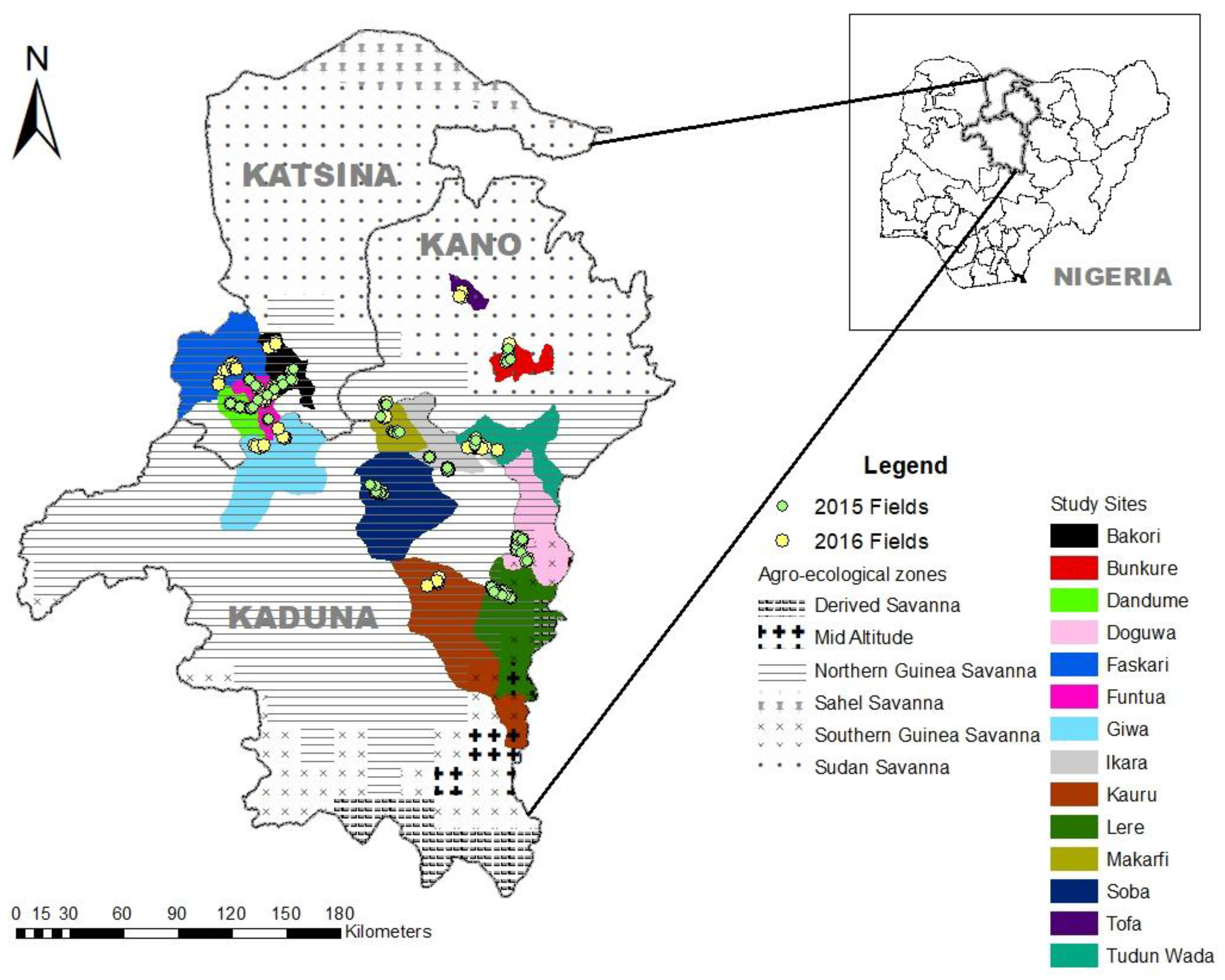
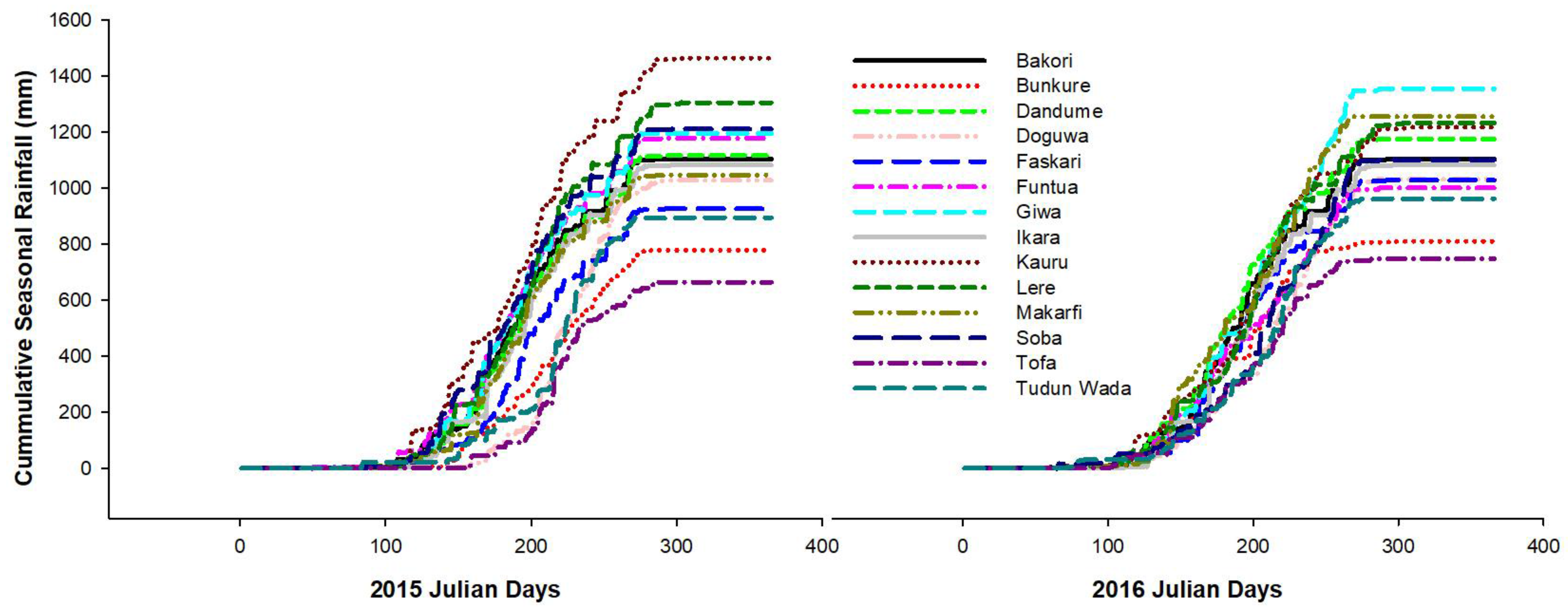
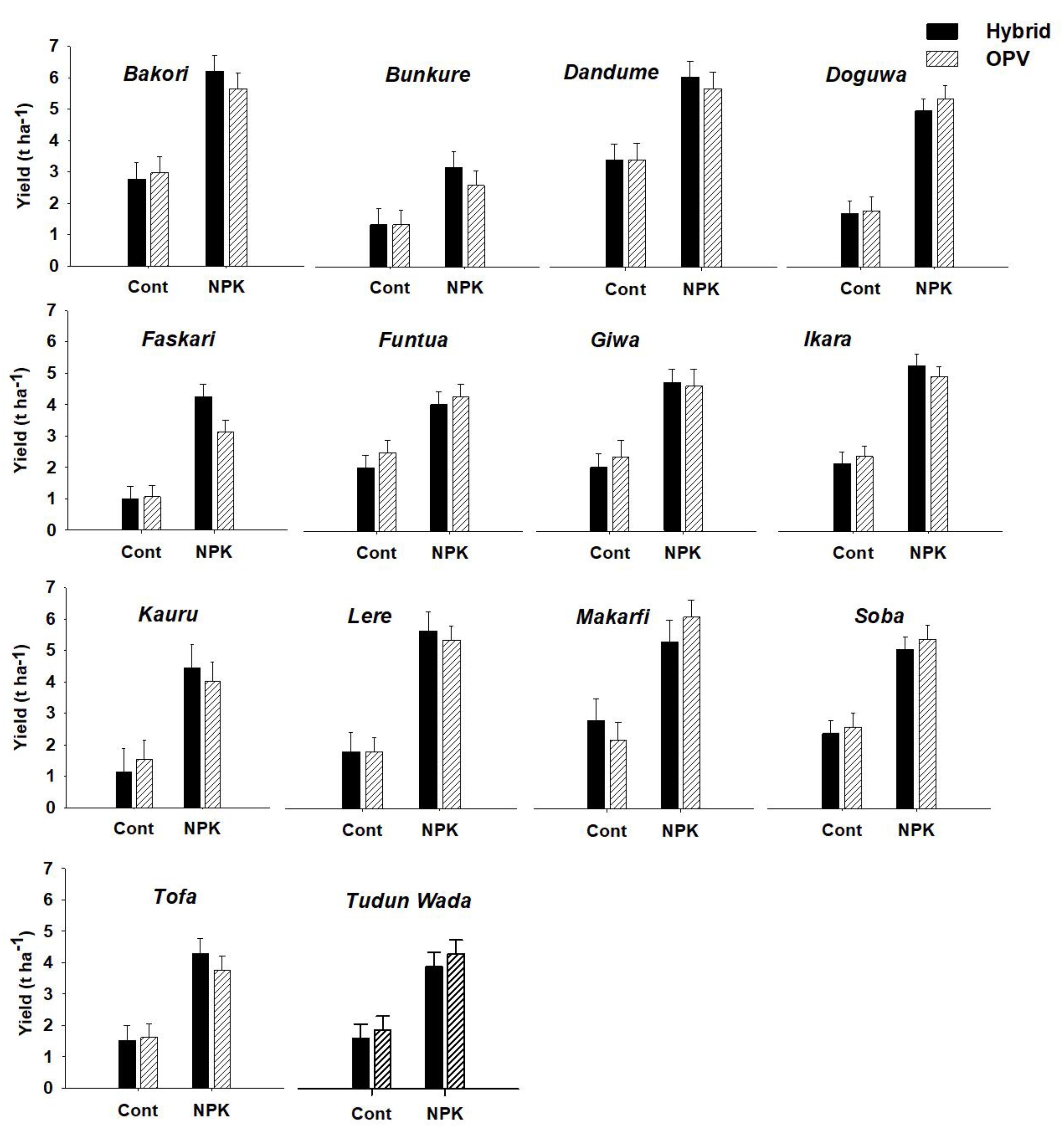
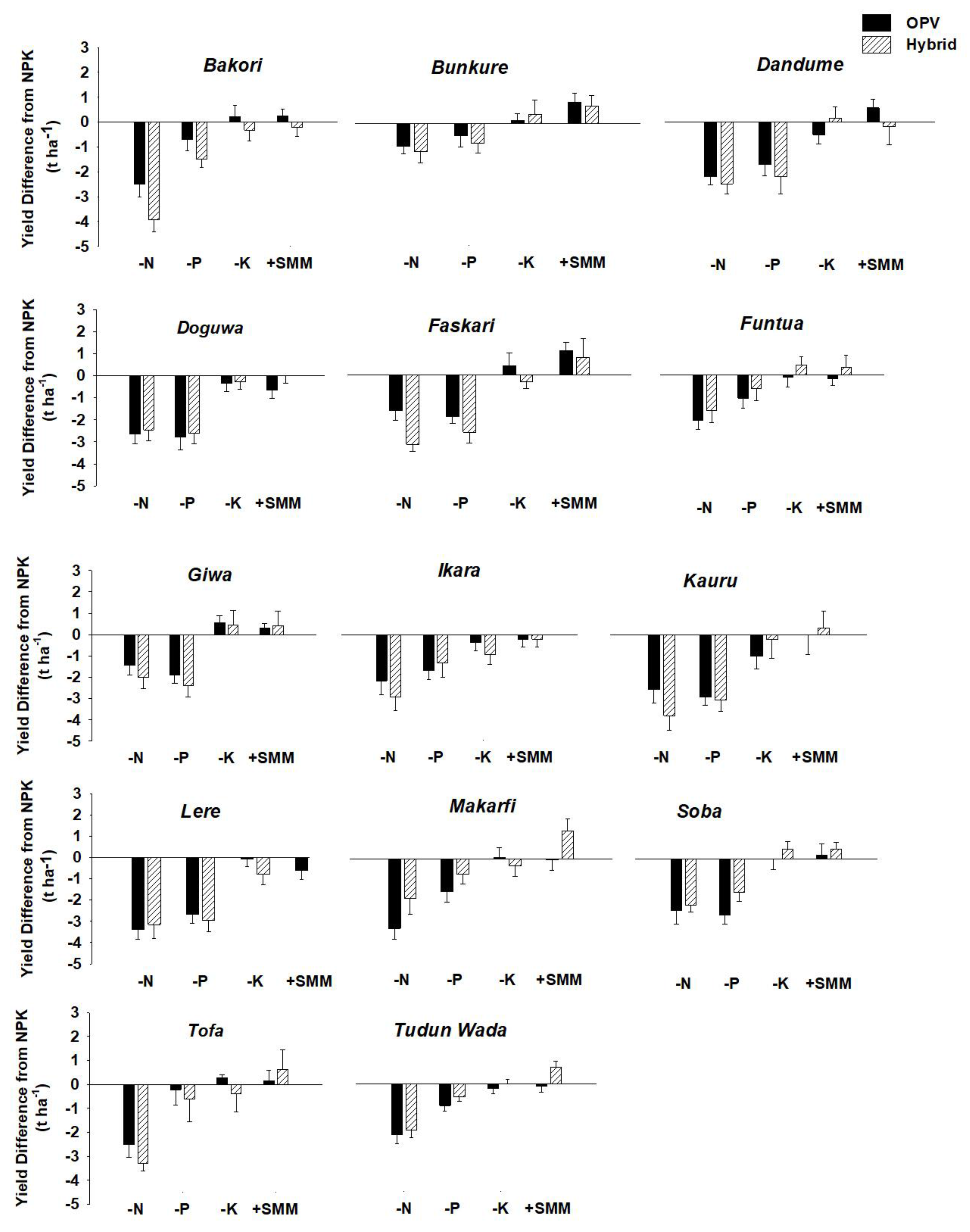
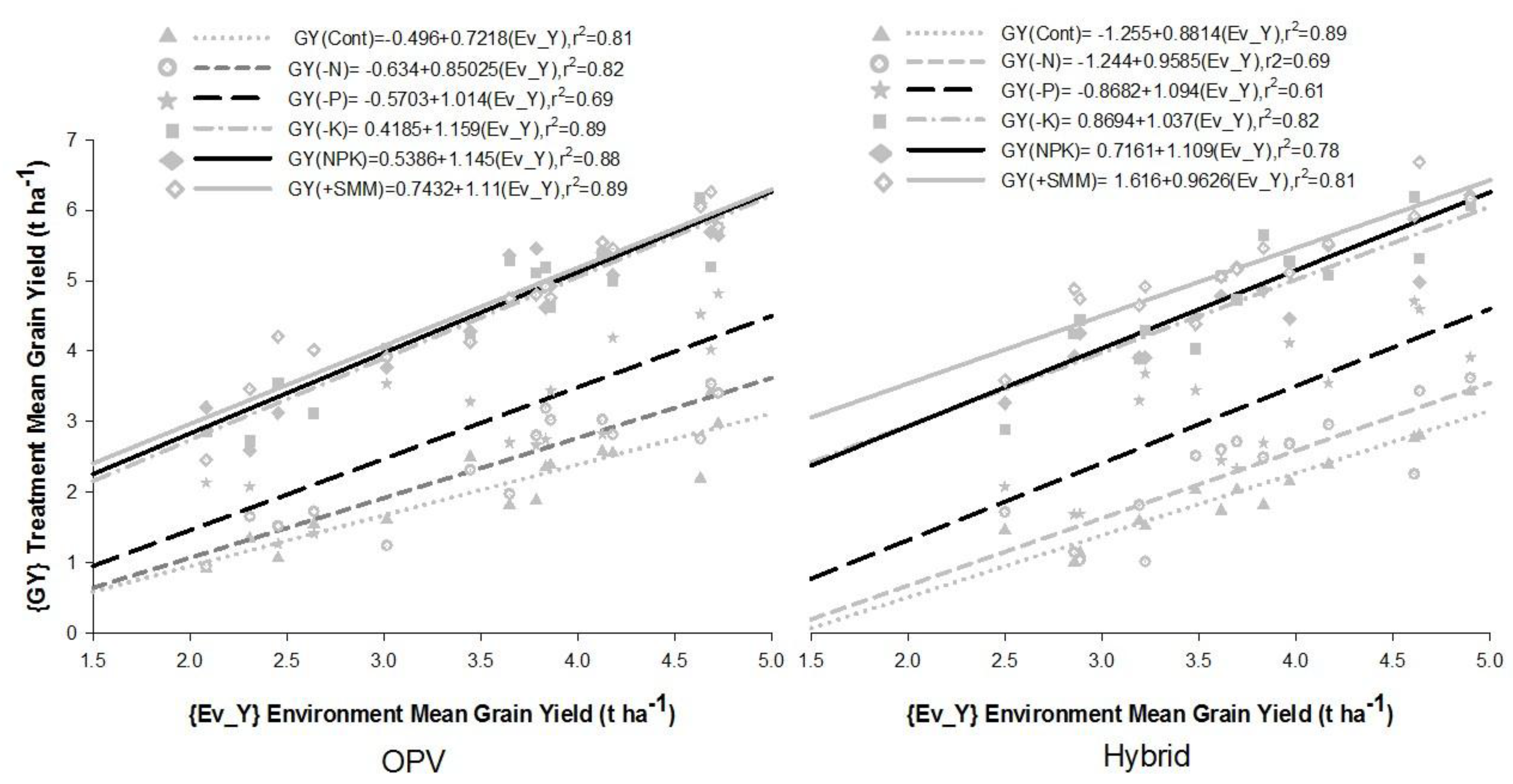
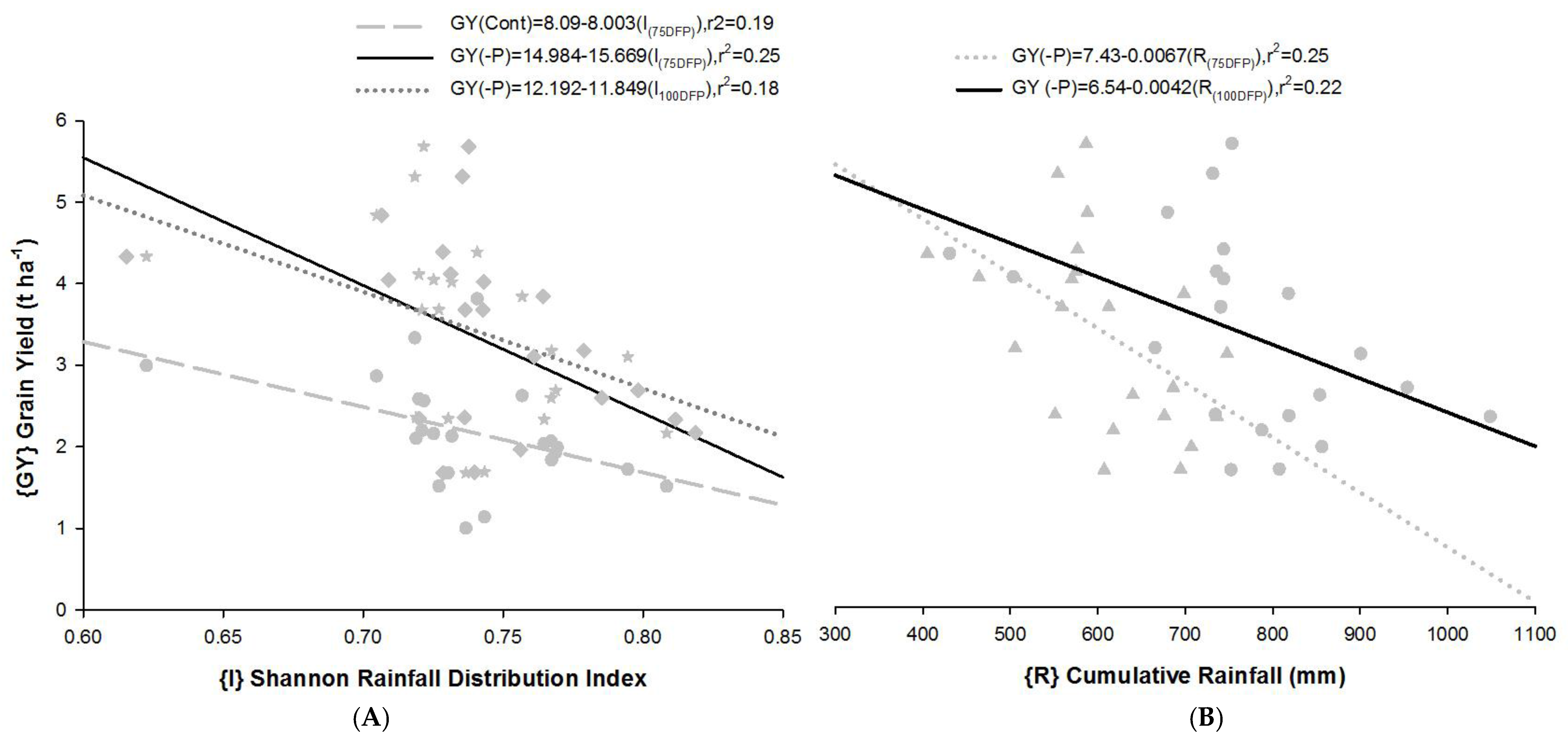
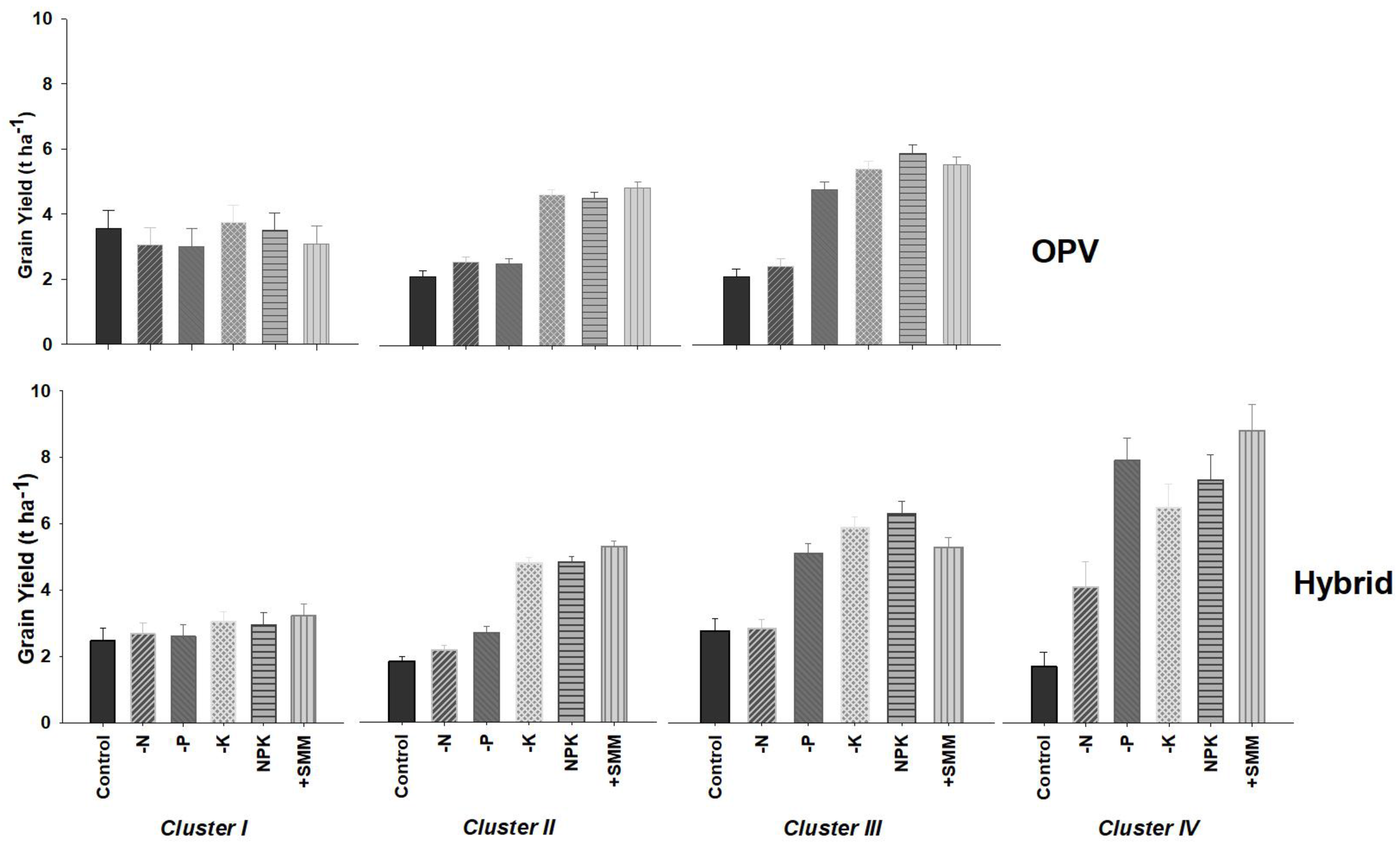
| Study Sites | State | Agro-Ecological Zone | Major Soil Types | No. of Experimental Fields | Year (Season) |
|---|---|---|---|---|---|
| Bakori | Katsina | NGS | Luvisols, Lixisols [32,33] | 20 | 2015 & 2016 |
| Bunkure | Kano | SS | Cambisols & Acrisols [34] | 15 | 2015 & 2016 |
| Dandume | Katsina | NGS | Lixisols, Cambisols & Luvisols [35] | 15 | 2015 & 2016 |
| Doguwa | Kano | NGS | Plinthosols [34] | 20 | 2015 & 2016 |
| Faskari | Katsina | NGS | Lixisols, Cambisols & Luvisols [35] | 10 | 2016 |
| Funtua | Katsina | NGS | Lixisols, Cambisols & Luvisols [35] | 19 | 2015 & 2016 |
| Giwa | Kaduna | NGS | Cambisols & Acrisols [36] | 10 | 2016 |
| Ikara | Kaduna | NGS | Cambisols & Acrisols [36] | 18 | 2015 & 2016 |
| Kauru | Kaduna | NGS | Lixisols [32] | 5 | 2016 |
| Lere | Kaduna | NGS | Acrisols & Lixisols [36] | 15 | 2015 & 2016 |
| Makarfi | Kaduna | NGS | Cambisols & Acrisols [36] | 14 | 2015 & 2016 |
| Soba | Kaduna | NGS | Cambisols & Acrisols [36] | 18 | 2015 & 2016 |
| Tofa | Kano | SS | Plinthosols [37] | 5 | 2016 |
| Tudun Wada | Kano | NGS | Cambisols, Plinthosols & Gleysols [34] | 14 | 2015 & 2016 |
| Total | 198 |
| Study Sites | Sand | Silt | Clay | Bulk Density | pHH2O | Total C | Total N | Avail. P | Avail. S |
|---|---|---|---|---|---|---|---|---|---|
| (%) | (%) | (%) | (g·cm−3) | (g·kg−1) | (g·kg−1) | (mg·kg−1) | (mg·kg−1) | ||
| Bakori | 51 (7) | 30 (6) | 19 (3) | 1.48 (0.11) | 6.2 (0.4) | 6.40 (2.15) | 0.37 (0.07) | 3.96 (3.70) | 6.41 (1.06) |
| Bunkure | 68 (4) | 17 (4) | 14 (2) | 1.54 (0.13) | 6.4 (0.5) | 4.74 (2.23) | 0.29 (0.06) | 10.90 (9.20) | 5.21 (0.88) |
| Dandume | 46 (8) | 32 (8) | 22 (4) | 1.60 (0.05) | 5.8 (0.4) | 7.44 (2.22) | 0.46 (0.08) | 4.00 (2.35) | 7.39 (1.08) |
| Doguwa | 36 (6) | 35 (5) | 29 (6) | 1.51 (0.16) | 5.8 (0.5) | 8.39 (2.03) | 0.55 (0.12) | 12.52 (7.66) | 8.32 (1.75) |
| Faskari | 46 (7) | 29 (6) | 25 (3) | 1.53 (0.17) | 5.6 (0.5) | 5.39 (1.07) | 0.46 (0.11) | 3.08 (3.04) | 6.95 (1.50) |
| Funtua | 43 (6) | 34 (6) | 23 (4) | 1.5 (0.07) | 5.8 (0.4) | 6.87 (2.51) | 0.46 (0.12) | 4.37 (3.40) | 7.10 (1.09) |
| Giwa | 43 (6) | 34 (5) | 23 (3) | 1.47 (0.14) | 5.8 (0.6) | 6.31 (1.45) | 0.53 (0.12) | 9.88 (9.22) | 7.10 (0.84) |
| Ikara | 48 (8) | 30 (5) | 22 (6) | 1.57 (0.15) | 5.6 (0.4) | 6.55 (2.43) | 0.45 (0.08) | 12.73 (8.68) | 7.28 (1.64) |
| Kauru | 57 (4) | 21 (7) | 22 (4) | 1.56 (0.09) | 5.7 (0.2) | 6.34 (0.54) | 0.46 (0.05) | 18.34 (1.78) | 7.66 (1.59) |
| Lere | 54 (8) | 24 (4) | 22 (6) | 1.60 (0.10) | 5.7 (0.5) | 5.85 (1.71) | 0.38 (0.10) | 9.22 (6.86) | 6.77 (0.97) |
| Makarfi | 45 (8) | 33 (5) | 22 (6) | 1.55 (0.15) | 5.7 (0.4) | 7.6 (2.66) | 0.43 (0.09) | 9.56 (9.43) | 7.56 (1.44) |
| Soba | 44 (7) | 36 (6) | 20 (3) | 1.59 (0.11) | 5.9 (0.4) | 8.28 (2.94) | 0.51 (0.10) | 12.98 (8.55) | 7.34 (1.52) |
| Tofa | 70 (7) | 15 (4) | 15 (4) | 1.62 (0.04) | 5.7 (0.7) | 2.72 (0.72) | 0.25 (0.06) | 24.98 (2.79) | 5.39 (0.64) |
| Tudun Wada | 59 (7) | 23 (7) | 18 (3) | 1.52 (0.08) | 6.2 (0.6) | 6.21 (1.96) | 0.49 (0.10) | 17.24 (10.03) | 7.77 (1.41) |
| CV (%) | 22.4 | 27.7 | 26 | 8.0 | 8.4 | 37.6 | 28.5 | 87.7 | 21.1 |
| Study Sites | Ca | Mg | K | Na | Exchange Acidity | ECEC |
|---|---|---|---|---|---|---|
| (cmolc·kg−1) | (cmolc·kg−1) | (cmolc·kg−1) | (cmolc·kg−1) | (cmolc·kg−1) | (cmolc·kg−1) | |
| Bakori | 2.51 (0.52) | 0.82 (0.20) | 0.23 (0.17) | 0.09 (0.01) | 0.00 (0.00) | 3.64 (0.63) |
| Bunkure | 1.88 (0.88) | 0.51 (0.16) | 0.23 (0.10) | 0.08 (0.03) | 0.01 (0.04) | 2.69 (0.99) |
| Dandume | 2.16 (0.59) | 0.61 (0.19) | 0.17 (0.09) | 0.08 (0.01) | 0.00 (0.00) | 3.01 (0.69) |
| Doguwa | 2.82 (0.81) | 0.93 (0.30) | 0.2 (0.10) | 0.09 (0.02) | 0.03 (0.08) | 4.05 (0.96) |
| Faskari | 1.42 (0.27) | 0.73 (0.19) | 0.35 (0.21) | 0.09 (0.01) | 0.07 (0.10) | 2.64 (0.40) |
| Funtua | 2.43 (0.75) | 0.77 (0.26) | 0.2 (0.10) | 0.08 (0.02) | 0.03 (0.07) | 3.48 (0.84) |
| Giwa | 2.24 (0.56) | 1.00 (0.30) | 0.16 (0.07) | 0.09 (0.00) | 0.06 (0.09) | 3.54 (0.71) |
| Ikara | 2.26 (0.73) | 0.49 (0.23) | 0.28 (0.15) | 0.07 (0.02) | 0.10 (0.11) | 3.18 (0.89) |
| Kauru | 2.03 (0.27) | 0.81 (0.14) | 0.16 (0.07) | 0.09 (0.00) | 0.00 (0.00) | 3.07 (0.32) |
| Lere | 1.8 (0.83) | 0.48 (0.26) | 0.20 (0.05) | 0.07 (0.02) | 0.02 (0.04) | 2.55 (1.04) |
| Makarfi | 2.06 (0.65) | 0.68 (0.22) | 0.20 (0.16) | 0.08 (0.01) | 0.15 (0.31) | 3.16 (0.94) |
| Soba | 2.13 (0.58) | 0.72 (0.17) | 0.17 (0.08) | 0.08 (0.01) | 0.00 (0.00) | 3.09 (0.68) |
| Tofa | 2.64 (0.33) | 0.42 (0.13) | 0.19 (0.07) | 0.09 (0.00) | 0.09 (0.08) | 3.41 (0.39) |
| Tudun Wada | 3.21 (0.92) | 0.73 (0.24) | 0.27 (0.11) | 0.08 (0.02) | 0.00 (0.00) | 4.27 (1.20) |
| CV (%) | 34.6 | 39.2 | 59.8 | 23.2 | 3.4 | 29.0 |
| Study Sites | Zn | Cu | Mn | Fe | B |
|---|---|---|---|---|---|
| (mg·kg−1) | (mg·kg−1) | (mg·kg−1) | (mg·kg−1) | (mg·kg−1) | |
| Bakori | 8.88 (2.38) | 2.25 (0.77) | 24.24 (13.06) | 107.99 (31.10) | 0.02 (0.008) |
| Bunkure | 4.77 (2.49) | 1.47 (0.49) | 34.13 (23.77) | 202.89 (17.16) | 0.01 (0.004) |
| Dandume | 9.92 (4.87) | 2.70 (1.03) | 21.48 (5.59) | 106.41 (30.43) | 0.02 (0.008) |
| Doguwa | 12.60 (9.75) | 1.70 (1.02) | 40.49 (19.98) | 109.98 (44.14) | 0.05 (0.020) |
| Faskari | 2.28 (2.12) | 2.36 (0.59) | 30.90 (17.17) | 104.40 (28.57) | 0.02 (0.005) |
| Funtua | 4.81 (2.30) | 1.76 (0.63) | 33.44 (36.33) | 217.86 (116.88) | 0.03 (0.017) |
| Giwa | 9.72 (5.59) | 1.49 (0.56) | 36.86 (12.96) | 131.4 (117.70) | 0.03 (0.011) |
| Ikara | 6.7 (3.48) | 1.84 (1.06) | 33.36 (22.94) | 183.57 (50.09) | 0.03 (0.019) |
| Kauru | 15.30 (1.66) | 1.13 (0.49) | 41.77 (7.88) | 133 (36.83) | 0.07 (0.040) |
| Lere | 4.71 (2.40) | 1.58 (0.63) | 30.57 (20.21) | 203.59 (79.25) | 0.04 (0.019) |
| Makarfi | 9.65 (8.37) | 2.01 (0.74) | 20.80 (9.79) | 129.50 (59.73) | 0.02 (0.010) |
| Soba | 10.98 (5.37) | 2.20 (1.16) | 43.01 (20.58) | 104.25 (38.97) | 0.02 (0.011) |
| Tofa | 6.73 (0.73) | 1.49 (0.40) | 77.39 (8.38) | 158.30 (9.78) | 0.01 (0.012) |
| Tudun Wada | 14.78 (8.46) | 1.58 (0.66) | 45.21 (17.49) | 231.01 (78.66) | 0.05 (0.030) |
| CV (%) | 72.8 | 46.5 | 64 | 51.6 | 81.7 |
| Grain Yield (Control) | Grain Yield (−N) | Grain Yield (−P) | Grain Yield (−K) | Grain Yield (NPK) | Grain Yield (+SMM) | |
|---|---|---|---|---|---|---|
| I (25 DFP) | 0.30 | 0.29 | 0.09 | 0.04 | 0.24 | 0.10 |
| R (25 DFP) | 0.07 | 0.09 | −0.02 | −0.15 | −0.01 | 0.03 |
| I (50 DFP) | −0.11 | −0.07 | −0.25 | −0.07 | 0.07 | −0.11 |
| R (50 DFP) | −0.14 | −0.10 | −0.21 | −0.14 | −0.13 | −0.15 |
| I (50–75 DFP) | −0.22 | −0.12 | −0.19 | 0.18 | −0.01 | −0.11 |
| R (50–75 DFP) | −0.17 | −0.02 | −0.13 | 0.33 | 0.18 | −0.01 |
| I (75 DFP) | −0.25 | −0.12 | −0.33 | 0.14 | 0.05 | −0.15 |
| R (75 DFP) | −0.29 | −0.11 | −0.31 | 0.19 | 0.05 | −0.13 |
| I (100 DFP) | −0.15 | 0.05 | −0.28 | 0.19 | 0.09 | −0.12 |
| R (100 DFP) | −0.18 | 0.01 | −0.27 | 0.14 | 0.04 | −0.17 |
| Grain Yield (Control) | Grain Yield (−N) | Grain Yield (−P) | Grain Yield (−K) | Grain Yield (NPK) | Grain Yield (+SMM) | |
|---|---|---|---|---|---|---|
| I (25 DFP) | 0.17 | 0.29 | 0.17 | 0.13 | 0.26 | −0.09 |
| R (25 DFP) | 0.10 | 0.01 | 0.14 | −0.05 | 0.21 | −0.15 |
| I (50 DFP) | −0.17 | −0.01 | −0.21 | −0.10 | 0.25 | −0.29 |
| R (50 DFP) | −0.13 | −0.15 | −0.19 | −0.11 | 0.09 | −0.20 |
| I (50–75 DFP) | −0.40 | −0.18 | −0.42 | −0.22 | −0.23 | −0.14 |
| R (50–75 DFP) | −0.30 | −0.03 | −0.36 | −0.11 | −0.14 | 0.02 |
| I (75 DFP) | −0.44 * | −0.22 | −0.50 * | −0.24 | −0.04 | −0.30 |
| R (75 DFP) | −0.39 | −0.18 | −0.50 * | −0.18 | −0.01 | −0.14 |
| I (100 DFP) | −0.35 | −0.17 | −0.43 * | −0.24 | −0.12 | −0.34 |
| R (100 DFP) | −0.31 | −0.11 | −0.47 * | −0.11 | 0.03 | −0.22 |
| Study Sites | OPV | Hybrid | |||||
|---|---|---|---|---|---|---|---|
| Cluster I | Cluster II | Cluster III | Cluster I | Cluster II | Cluster III | Cluster IV | |
| Bakori | 3 | 7 | 6 | 1 | 11 | 4 | 1 |
| Bunkure | 1 | 11 | 1 | 7 | 3 | 1 | 1 |
| Dandume | 2 | 8 | 3 | 2 | 8 | 3 | 0 |
| Doguwa | 1 | 13 | 3 | 2 | 14 | 1 | 0 |
| Faskari | 0 | 7 | 1 | 0 | 7 | 1 | 0 |
| Funtua | 4 | 8 | 5 | 4 | 7 | 6 | 0 |
| Giwa | 0 | 7 | 1 | 0 | 7 | 1 | 0 |
| Ikara | 2 | 8 | 8 | 1 | 10 | 5 | 1 |
| Kauru | 0 | 5 | 0 | 0 | 5 | 0 | 0 |
| Lere | 0 | 9 | 5 | 2 | 10 | 2 | 0 |
| Makarfi | 0 | 6 | 6 | 4 | 5 | 1 | 2 |
| Soba | 1 | 13 | 2 | 2 | 11 | 3 | 0 |
| Tofa | 0 | 2 | 3 | 0 | 4 | 1 | 0 |
| Tudun Wada | 1 | 5 | 6 | 3 | 7 | 1 | 2 |
| Total | 15 (9.0%) | 109 (63.0%) | 50 (28.0%) | 28 (16.0%) | 109 (63.0%) | 30 (17.0%) | 7 (4.0%) |
| # Cluster I | Cluster II | Cluster III | Cluster IV | ||||
|---|---|---|---|---|---|---|---|
| Mean | Mean | Odds Ratio | Mean | Odds Ratio | Mean | Odds Ratio | |
| Soil Characteristics | |||||||
| pH | 6.0 | 5.8 | 0.54 | 5.9 | 0.66 | 6.0 | 0.98 |
| OC (g·kg−1) | 7.7 | 6.97 | 0.81 * | 6.52 | 0.75 * | 5.98 | 0.45 * |
| N (g·kg−1) | 0.44 | 0.46 | 1.52 | 0.45 | 3.26 | 0.49 | >1000 |
| P (mg·kg−1) | 7.76 | 8.72 | 1.05 | 11.21 | 1.09 ** | 17.70 | 1.20 ** |
| Sand (%) | 50.94 | 47.72 | el | 49.47 | el | 50.8 | el |
| Silt (%) | 28.12 | 29.71 | el | 29.89 | el | 29.09 | el |
| Clay (%) | 20.95 | 22.59 | el | 20.64 | el | 20.12 | el |
| Ca (cmolc·kg−1) | 2.38 | 2.38 | 1.13 | 2.30 | 1.03 | 2.96 | 2.12 |
| Mg (cmolc·kg−1) | 0.63 | 0.72 | 5.08 | 0.66 | 6.75 | 0.61 | 0.54 |
| K (cmolc·kg−1) | 0.22 | 0.23 | 2.87 | 0.22 | 2.50 | 0.21 | 3.07 |
| Na (cmolc·kg−1) | 0.08 | 0.08 | 0.59 | 0.08 | <0.001 | 0.09 | >1000 |
| E.A. (cmolc·kg−1) | 0.02 | 0.05 | el | 0.04 | el | 0.00 | el |
| ECEC (cmolc·kg−1) | 3.31 | 3.44 | el | 3.28 | el | 3.86 | el |
| Zn (mg·kg−1) | 8.74 | 8.57 | 1.00 | 8.70 | 1.02 | 14.21 | 1.07 |
| Cu (mg·kg−1) | 2.01 | 1.92 | 0.90 | 1.99 | 1.14 | 2.14 | 1.91 |
| Mn (mg·kg−1) | 29.78 | 33.75 | 0.98 | 34.42 | 0.98 | 39.83 | 0.93 |
| Fe (mg·kg−1) | 185.33 | 144.12 | 0.99 * | 157.22 | 0.99 | 165.48 | 0.99 |
| B.D. (g·cm−3) | 1.55 | 1.54 | 2.71 | 1.60 | 45.68 * | 1.50 | 9.67 |
| B (mg·kg−1) | 0.04 | 0.03 | <0.001 | 0.02 | <0.001 | 0.01 | <0.001 * |
| S (mg·kg−1) | 6.95 | 7.38 | 1.42 * | 6.99 | 1.34 | 6.68 | 1.44 |
| Fertilizer Management History | |||||||
| Farm Size (ha) | 1.29 | 1.56 | el | 1.17 | el | 0.54 | el |
| Organic fertilizer (kg·ha−1) | 6052.67 | 4035.72 | 0.99 | 2129.27 | 0.98 * | 2120 | 0.99 |
| NPK fertilizer (kg·ha−1) | 223.08 | 166.82 | el | 252.75 | el | 280.4 | el |
| SSP fertilizer (kg·ha−1) | 0.00 | 4.76 | el | 9.45 | el | 9.1 | el |
| UREA fertilizer (kg·ha−1) | 36.17 | 77.99 | el | 96.53 | el | 229.87 | el |
© 2018 by the authors. Licensee MDPI, Basel, Switzerland. This article is an open access article distributed under the terms and conditions of the Creative Commons Attribution (CC BY) license (http://creativecommons.org/licenses/by/4.0/).
Share and Cite
Shehu, B.M.; Merckx, R.; Jibrin, J.M.; Kamara, A.Y.; Rurinda, J. Quantifying Variability in Maize Yield Response to Nutrient Applications in the Northern Nigerian Savanna. Agronomy 2018, 8, 18. https://doi.org/10.3390/agronomy8020018
Shehu BM, Merckx R, Jibrin JM, Kamara AY, Rurinda J. Quantifying Variability in Maize Yield Response to Nutrient Applications in the Northern Nigerian Savanna. Agronomy. 2018; 8(2):18. https://doi.org/10.3390/agronomy8020018
Chicago/Turabian StyleShehu, Bello M., Roel Merckx, Jibrin M. Jibrin, Alpha Y. Kamara, and Jairos Rurinda. 2018. "Quantifying Variability in Maize Yield Response to Nutrient Applications in the Northern Nigerian Savanna" Agronomy 8, no. 2: 18. https://doi.org/10.3390/agronomy8020018
APA StyleShehu, B. M., Merckx, R., Jibrin, J. M., Kamara, A. Y., & Rurinda, J. (2018). Quantifying Variability in Maize Yield Response to Nutrient Applications in the Northern Nigerian Savanna. Agronomy, 8(2), 18. https://doi.org/10.3390/agronomy8020018






